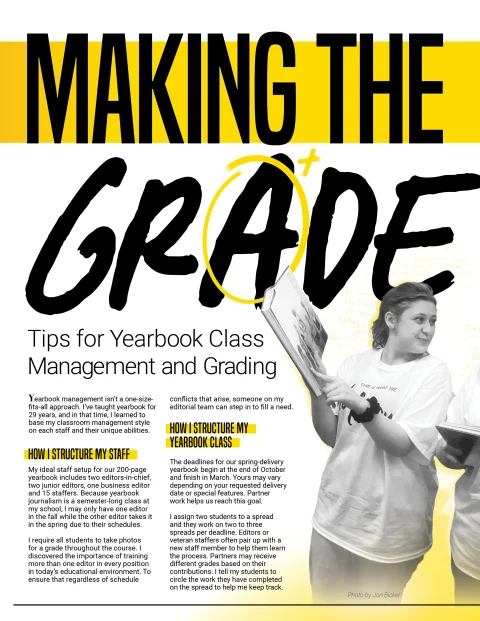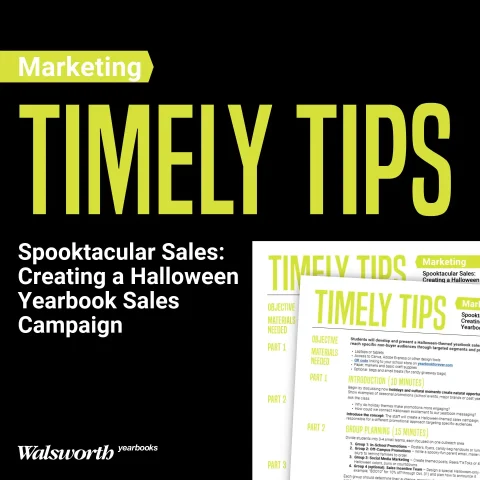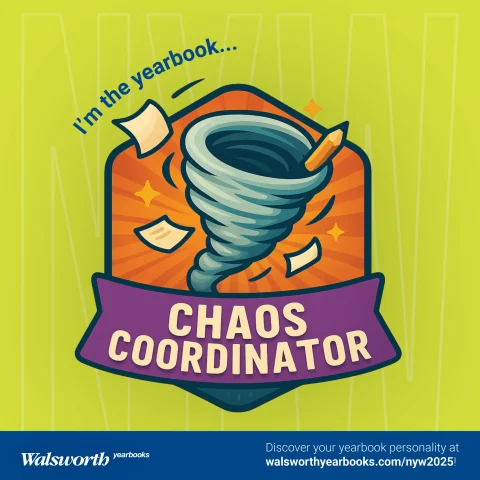Yearbook management isn’t a one-size-fits-all approach. I’ve taught yearbook for 29 years, and in that time, I learned to base my classroom management style on each staff and their unique abilities.
How I Structure My Staff
My ideal staff setup for our 200-page yearbook includes two editors-in-chief, two junior editors, one business editor and 15 staffers. Because yearbook journalism is a semester-long class at my school, I may only have one editor in the fall while the other editor takes it in the spring due to their schedules.
I require all students to take photos for a grade throughout the course. I discovered the importance of training more than one editor in every position in today’s educational environment. To ensure that regardless of schedule conflicts that arise, someone on my editorial team can step in to fill a need.
How I Structure My Yearbook Class
The deadlines for our spring-delivery yearbook begin at the end of October and finish in March. Yours may vary depending on your requested delivery date or special features. Partner work helps us reach this goal.
I assign two students to a spread and they work on two to three spreads per deadline. Editors or veteran staffers often pair up with a new staff member to help them learn the process. Partners may receive different grades based on their contributions. I tell my students to circle the work they have completed on the spread to help me keep track.
How I Manage Assignments, Grading and Deadlines
Grading can be challenging for a class like yearbook, so much of my grading comes from the assigned deadlines. I use a point system and will list the point values as a reference point, but you can adjust those based on your needs.
Mini-deadlines are Key. These mini-deadlines serve two functions: they allow students to work ahead and to stay on schedule. If I tell students a final date, they work to that date and turn in rushed work with unnecessary errors. Having multiple deadlines used for grading allows us to work several weeks out. As a bonus, it gives me additional opportunities to assign a grade. Each mini-deadline is worth 20 points unless otherwise noted.
- Layout Deadline. My editors create layouts in the summer before the deadline season begins, so this initial deadline does not affect everyone. A yearbook workshop or camp offers the perfect opportunity for this. Editors can then tweak the layouts based on the photos taken during the year as staffers start working. Editors receive a grade for designing the layouts, worth 50 points.
- Photo Deadline. All staffers have photo assignments and photography grades due every two weeks. The students assigned to the spreads plan the shots and photograph the events unless work or extracurricular activities interfere. But this first official deadline, worth 50 points, is where we choose the best photos for a layout. We do this before staffers begin interviewing students for the next deadline to save everyone time and frustration. Editors earn a separate grade for giving feedback on the photos.
- Caption & Interview Deadline. Interview notes are due a week after the photo deadline to give staffers time to complete the interviews. I must have access to these forms for our records. The caption sheets, worth 50 points, should also be turned in at this time.
- Copy & Story Deadline. Students need time to compile their thoughts when writing copy. For a sports story, we focus on the biggest or most exciting moment while still including details about the entire season. For clubs or academics, we start with the dominant photo. After staffers submit their work, they receive a 50-point Editors must look over the stories in addition to working on their own assigned spreads.
- First Draft Deadline. I expect everything to be completed on the spread, including design, photo credits, copy and folio quotes, along with a mandatory spell check and read-through of their work. Because of the amount of work required, I assign 100 points to this deadline. Editors are expected to give feedback as well.
- Final Draft Deadline. A few days after the first draft, students turn in their final draft with all their edits and fine-tuning complete. This is also worth 100 points.
- Page Submission Deadline. One week later, we submit. My editors split the pages and make final edits before we submit them, with the business editor helping if they do not have a business deadline.
Other Assignments: At the beginning of the school year, my team designs our theme, alternative coverage and internal spread layouts. We finalize our theme while attending yearbook summer camp and go from there.
I train new staff on photography first so we can get great photos all year. Then, I move to interviewing and captions, before finally teaching story writing. I give project-based assignments and an occasional quiz.
After we submit the final pages in the spring, we work on theme, design, layouts, etc. This includes a theme packet for a grade worth as much as a deadline, with the knowledge that our theme may still change during yearbook workshops over the summer.
These strategies have served me well, and I hope they offer you practical solutions to implement in your classroom. If you have any questions, please feel free to contact me at jbickel@elcosd.org.





